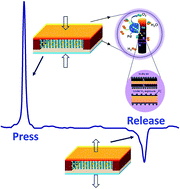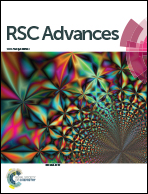A self-powered active hydrogen sensor based on a high-performance triboelectric nanogenerator using a wrinkle-micropatterned PDMS film
Abstract
A triboelectric nanogenerator powered room-temperature hydrogen (H2) sensor was fabricated using ZnO nanorod (NR) arrays decorated with Pd nanoparticles (NPs) and a wrinkle-micropatterned polydimethylsiloxane (PDMS) nanogenerator. A generated open-circuit voltage of 16.2 V and short-circuit current of 0.512 μA were obtained when the device was exposed to a 5.3 N contact force at a fixed pressing frequency of 3 Hz. The instantaneous output power density from the device was 15.81 μW cm−2 when connected to a load resistor of 1 MΩ. The triboelectric output of the as-fabricated device was attributed to the enhanced triboelectrification of the wrinkle-micropatterned PDMS and the synergistic interplay of Pd/ZnO heterojunctions, which effectively acted as both the energy source and H2 sensing signal. Upon exposure to 3 vol% H2 at room temperature under the same applied force and deformation frequency, the triboelectric output voltage of the device decreased from 16.2 V (in dry air) to 1.04 V, through which a response value (sensitivity) up to 1457.69% was obtained. The device also showed an excellent low limit of detection (20 ppm), but a relatively slow response–recovery time (115–126 s). These results suggest that the device can be used in practical applications and can stimulate new research for the development of next-generation portable self-powered active H2 sensors.



 Please wait while we load your content...
Please wait while we load your content...